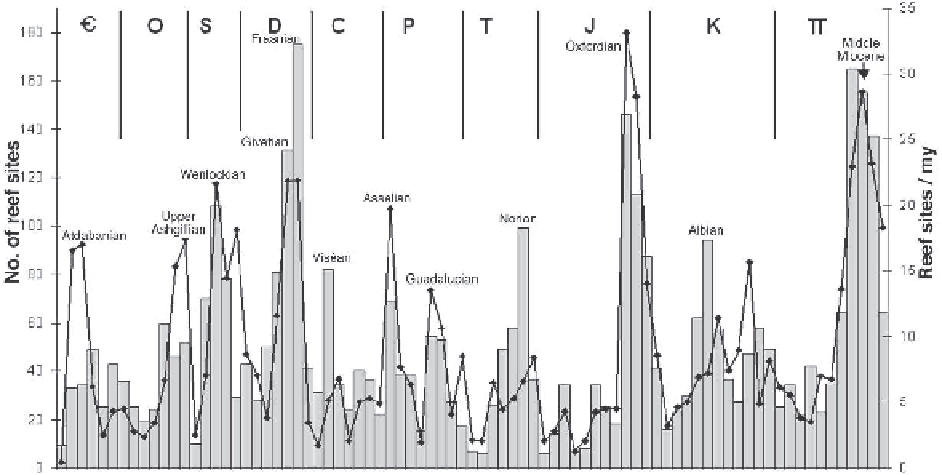Geology Reference
In-Depth Information
Fig. 16.23
.
Abundance of Phanerozoic reefs
expressed by the absolute number of reef sites (lumps of age-equivalent reefs
from an area of more than 300 square kilometer; gray bars) and the number of reef sites per million years (line, scale at the
right) in the PaleoReef database calculated for stages. Global reef abundance was greatest in the Frasnian (mostly stromato-
poroid-coral reefs) and very high in the Givetian (stromatoporoid-coral reefs), Oxfordian (coral reefs and siliceous sponge-
microbial reefs) and Middle Miocene (coral reefs and algal reefs). Courtesy of W. Kiessling (Berlin).
Wenlockian, Givetian, Viséan, Asselian, Norian, Ox-
fordian, Albian and Miocene. High reef abundance is
independent of the dominant reefbuilders and associa-
tion of reef-building organisms. Most Wenlockian,
Givetian and Frasnian reefs are dominated by stromato-
poroids and corals, but Frasnian mud mounds exhibit
high microbial contributions, similar to Viséan reef
mounds in which microbes and bryozoans are of im-
portance. Most Early Permian Asselian reefs are algal
reefs. Guadalupian reefs are rich in coralline calcare-
ous sponges similar to Norian reefs. Oxfordian reefs
include reefs formed by siliceous sponges and microbes
as well as scleractinian coral reefs. Albian reefs are
usually rudist bivalve and/or coral reefs. Seravallian
(mid-Miocene) reefs are characterized by coralline al-
gae and corals.
which is not reflected by a reef gap or a global reef
crisis.
• Major mass extinctions are usually associated with
reef crises, but different rankings in the magnitudes of
reef crises and extinctions exist. Coincidences exist for
the Early-Middle Cambrian, end-Ordovician, Middle
Permian-Late Permian and Permian-Triassic events.
Reef crises were of a higher magnitude than coeval
mass extinctions at the Mississippian-Pennsylvanian,
Triassic-Jurassic, Jurassic-Cretaceous, and Cenoma-
nian-Turonian boundaries.
• Reef crises affected all reef-building organisms in-
cluding sponges, corals and bivalves, and occasionally
also microbes. A bloom of microbes occurs after reef
crises and mass extinctions, but is not a universal rule,
as is usually argued.
Global extinction events affected reef abundance in
different ways.
If global reef crises are defined as sig-
nificant drops in global reefal carbonate production
(Flügel and Kiessling 2002), and not by the measure
of diversity, eight first-order reef crises with a carbon-
ate production loss > 90% can be distinguished.
The analysis of these reef crises exhibits the follow-
ing patterns:
• Mass extinctions do not necessarily cause reef cri-
ses as exemplified by the end-Ordovician, the Carnian-
Norian turnover, and the Cretaceous-Tertiary event,
Constructional reef types.
There is an overall trend
to a relative increase in true (ecologic) reefs and reef
mounds and a relative decrease in mud mounds during
the Phanerozoic. True reefs and reef mounds dominated
during the Paleozoic. Mud mounds were common or
predominant only in the Paleozoic, particularly in the
Early Paleozoic. The most prominent increase in true
reefs occurred in the Tertiary.
Reef dimensions.
Reef thickness is most likely the
significant measure of reef dimensions. Fig. 16.24

